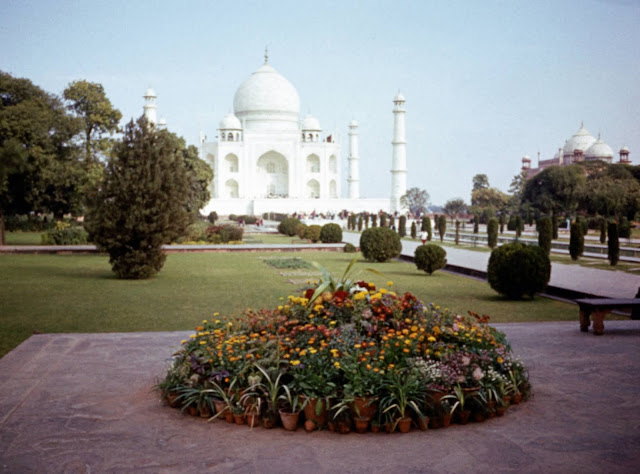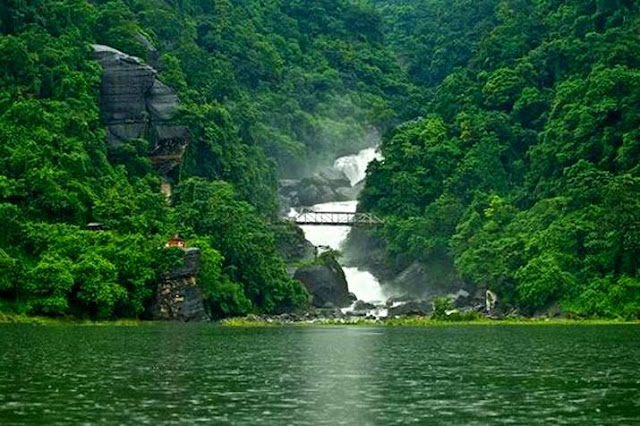 |
| Taj Mahal |
The Taj Mahal might be an amazing white-marble sepulcher
authorized by Mughul Emperor Shah Jahan for his adored spouse, Mumtaz Mahal.
Situated on the southern bank of the Yamuna River close to Agra, India, the Taj
Mahal required 22 years to make and ultimately arrived at finishing in 1653.
This flawless landmark is viewed as one of the New Wonders of
the planet flabbergasts guests for its balance, underlying magnificence,
unpredictable calligraphy, trimmed gemstones, and a rich nursery. very a
dedication inside the name of a companion, the Taj Mahal was a presentation of
enduring affection from Shan Jahan to his left perfect partner.
The sentiment
It was in 1607 that Shah Jahan, grandson of Akbar the great,
initially met his adored. At that point, he wasn't yet the fifth ruler of the
Mughal Empire. Sixteen-year-old Prince Khurram, as he was then called, bounced
around the regal market, playing with the ladies from high-positioning families
that staffed the stalls.
At one among these stalls, Prince Khurram met Arjumand Banu
Begum, the 15-year-old young lady whose father was destined to be the executive
and whose auntie was hitched to Prince Khurram's dad. In spite of the fact that
it had been love at first sight, the 2 weren't permitted to wed
straightforwardly. Sovereign Khurram previously needed to wed Kandahari Begum.
He later took a third spouse moreover.
On March 27, 1612, Prince Khurram and his darling, to whom
he gave the name Mumtaz Mahal ("picked one among the royal
residence"), were hitched. Mumtaz Mahal was lovely additionally as shrewd
and gracious. the overall population was enchanted along with her, in no little
part since she really focused on individuals. She constantly made arrangements
for widows and vagrants to ensure that they got food and cash. The couple had 14
youngsters together yet just seven lived past earliest stages. it had been the
introduction of the fourteenth kid that may slaughter Mumtaz Mahal.
The Death of Mumtaz Mahal
In 1631, three years into Shah Jahan's rule, insubordination drove by Khan Jahan Lodi was in progress. Shah Jahan took his
military bowed the Deccan, around 400 miles from Agra, to smash the usurper.
Of course, Mumtaz Mahal went with Shah Jahan's side in spite
of being intensely pregnant. On June 16, 1631, she brought forth a sound little
girl in an intricately adorned tent inside the center of the place to stay.
From the start, all gave off an impression of being, yet Mumtaz Mahal was
before long biting the dust.
The second Shah Jahan got an expression of his better half's
condition, he raced to her side. Ahead of schedule inside the morning on June
17, just a single day after the introduction of their girl, Mumtaz Mahal kicked
the bucket in her significant other's arms. She was covered straightforwardly
predictable with Islamic custom close to the settlement at Burbanpur. Her body
wouldn't remain there long.
Reports say that in Shah Jahan's pain, he visited his tent
and wept for eight days consistently. At the point when he arose, he was said
to have matured significantly, wearing white hair and glasses.
 |
| Grave of Momotaj |
Bringing Mumtaz Mahal Home
In December 1631, with the fight against Khan Jahan Lodi
won, Shah Jahan asked that Mumtaz Mahal's body be uncovered and carried 435
miles or 700 kilometers to Agra. Her return was an amazing parade with a huge
number of fighters going with her body and grievers covering the course.
At the point when the remaining parts of Mumtaz Mahal
arrived at Agra on January 8, 1632, they were incidentally covered aground
given by aristocrat Raja Jai Singh. This was close to where the Taj Mahal would
be constructed.
Plans for the Taj Mahal
Shah Jahan, packed with anguish, emptied his feeling into
planning an intricate and costly catacomb that may bring all individuals who
needed to go before it to disgrace. it had been additionally special in that it
had been the essential huge sepulcher devoted to a woman.
Albeit no essential designer for the Taj Mahal is perceived,
it's accepted that Shah Jahan, guided into engineering himself, chipped away at
the plans straightforwardly with the info and help of the assortment of the
easiest draftsmen of his time. The goal was for the Taj Mahal, "the crown
of the area", to address Heaven, Jannah, on Earth. Shah Jahan pulled out
all the stops in getting this going.
Building the Taj Mahal
The Mughal Empire was probably the most extravagant domain
inside the world at the hour of Shah Jahan's rule, and this implied that he had
the assets to frame this landmark exceptionally fantastic. Be that as it may,
however, he needed it to be stunning, he likewise needed it raised rapidly.
To accelerate the get-together, an expected 20,000 laborers
were brought during and housed close by in a town assembled particularly for
them called Mumtazabad. Both talented and incompetent experts were contracted.
Developers originally worked on the motivation then on the
huge, 624-foot-long plinth or base. this can turn into the lower part of the
Taj Mahal building and subsequently the pair of coordinating with red sandstone
structures that may flank it, the mosque and visitor house.
The Taj Mahal, sitting on a subsequent plinth, was to be an
octagonal design built of marble-covered block. Similar to that the case for
some huge undertakings, the manufacturers made a platform to make higher. Their
selection of blocks for this platform was uncommon and stays baffling to
history specialists.
Marble
White marble is one of the chief striking and noticeable
highlights of the Taj Mahal. The marble utilized was quarried in Makrana, 200
miles away. Purportedly, it took 1,000 elephants and an untold number of bulls
to pull the very weighty marble to the empty parcel.
For the enormous marble pieces to prevail into higher spaces
of the Taj Mahal, a monster, 10-mile-long earthen incline was assembled. The
Taj Mahal is finished off with a gigantic twofold shelled arch that extends 240
feet and is also shrouded in white marble. Four slender, white marble minarets
stand tall at the sides of the subsequent plinth and encompass the catacomb.
Calligraphy and Inlaid Flowers
Most photos of the Taj Mahal show just an outsized white
structure. In spite of the fact that still stunning, this doesn't do the
significant construction equity. These photographs skip complexities and it's
these subtleties that make the Taj Mahal astoundingly female and rich.
On the mosque, visitor house, and the gigantic primary door
at the southern finish of the complex seem sections from the Quran or Koran,
the heavenly book of Islam, written in calligraphy. Shah Jahan employed expert
calligrapher Amanat Khan to figure on these trimmed refrains.
Unbelievably done, the completed stanzas from the Quran are
decorated with dark marble. they're dignified at this point delicate
component of the structure. Albeit produced using stone, the bends copy genuine
penmanship. The 22 entries from the Quran are said to have been picked by
Amanat Khan himself. Strangely, Amanat Khan was the sole one that Shah Jahan
permitted to sign his work on the Taj Mahal.
Practically more noteworthy than the calligraphy is the
delicate decorated blossoms found all through the Taj Mahal complex. during a
cycle alluded to as Parchin Kari, exceptionally gifted stone cutters cut mind-boggling botanical plans into the white marble at that point decorated these
with valuable and semi-valuable stones to make joined plants and blossoms.
There are 43 unique kinds of valuable and semi-valuable
stones utilized for these blossoms and that they came from around the world.
These incorporate lazuli from Sri Lanka, jade from China, malachite from
Russia, and turquoise from Tibet.
The Garden
Islam holds the picture of Paradise as a nursery. Hence, the
nursery at the Taj Mahal was an essential piece of making it Heaven on Earth.
The Taj Mahal's nursery, which is arranged toward the south
of the sepulcher, has four quadrants. These are isolated into four
"waterways" of water (another significant Islamic picture of
Paradise) that takes in a focal pool. The nurseries and streams were filled by
the Yamuna River through an opulent underground water framework. Lamentably, no
records stay to advise the exact plants in these nurseries.
 |
| Garden |
Shah Jahan's Death
Shah Jahan stayed in profound grieving for a very long time
and never completely recuperated after the demise of his number one spouse.
This gave Mumtaz Mahal and Shah Jahan's fourth child Aurangzeb the opportunity
to effectively execute his three senior siblings and detain his dad.
Following 30 years as sovereign, Shah Jahan was usurped and
put inside the sumptuous Red Fort in Agra in 1658. Taboo to disappear however
with the vast majority of his standard extravagances, Shah Jahan went through
his last eight years looking out a window at the Taj Mahal.
At the point when Shah Jahan passed on January 22, 1666,
Aurangzeb had his dad covered with Mumtaz Mahal inside the sepulcher underneath
the Taj Mahal. On the most floor of the Taj Mahal over the sepulcher currently
sits two cenotaphs (void public burial places). The one inside the focal point
of the space has a place with Mumtaz Mahal and along these lines, the one just
toward the west is for Shah Jahan.
Encompassing the cenotaphs might be a gently cut, fancy
marble screen. Initially, it had been a gold screen however Shah Jahan had that
supplanted so that cheats wouldn't feel enticed to take it.
Obliteration of the Taj Mahal
Shah Jahan was sufficiently affluent to help the Taj Mahal
and its strong upkeep costs, yet throughout the long term, the Mughal Empire
lost its wealth and thusly the Taj Mahal fell into ruins.
By the 1800s, the British expelled the Mughals and took over
India. The Taj Mahal was taken apart for its magnificence—the Britch cut
gemstones from its dividers, took silver candles and entryways, and
surprisingly attempted to sell the white marble abroad. it had been Lord
Curzon, British emissary of India, who put and to the present. rather than
plundering the Taj Mahal, Curzon attempted to resuscitate it.
The Taj Mahal Now
The Taj Mahal has again become an amazing spot with 2.5
million guests every year. Individuals can visit during the daytime and watch
on the grounds that the white marble seems to require various shades for the
duration of the day. When a month, guests get the opportunity to shape a
concise visit during a brimming with the moon to learn how the Taj Mahal
appears to sparkle from the inside call at the twilight.
The Taj Mahal was put on the World Heritage List by UNESCO
in 1











No comments